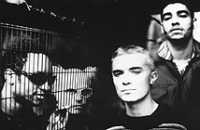FORMED: 1990, Braintree, Essex, England
The most successful holdover from the early-'90s rave/hardcore scene, the Prodigy initially scored with the 1991 U.K. hit "Charly" and became one of the decade's best-selling dance acts with a string of hit singles. Organized and fronted by Liam Howlett, the group also recorded acclaimed album works and toured the LPs with a stunning live show, which approximated the incendiary spirit of a rave better than any techno act.
Howlett (b. 1971), the prodigy behind the group's name, was classically trained on the piano while growing up in Braintree, Essex. Later, he began listening to rap and DJed with the hip-hop act Cut to Kill before moving on to acid-house in the late '80s. His first production, the EP What Evil Lurks, became a major mover on the fledgling rave scene. After Howlett met up with dancers Keith Flint and Leeroy Thornhill (both Essex natives as well), the trio formed the Prodigy in late 1990. The group gained a contract with XL Records and re-released What Evil Lurks in February 1991.
Six months later, Howlett issued his second single "Charly," built around a sample from a children's public-service announcement. It hit number one on the British dance charts, and then crossed over to the pop charts, stalling only at number three. "Charly" also spawned the copycat craze that launched the Smart E's "Sesame Street," one of the first rave singles to chart in America. Two additional Prodigy singles, "Everybody in the Place" and "Fire/Jericho," charted in the U.K. during late 1991 and early 1992.
The Prodigy showed they were no one-anthem wonders in September 1992, when the group released one of the first LPs by a rave act. The Prodigy Experience appeared on XL in Great Britain and Elektra in America, fluidly mixing previous material with future singles ("Out of Space," "Wind It Up"); it proved a major hit. During 1993, Howlett added a ragga/hip-hop MC named Maxim Reality (Keeti Palmer) and occupied himself with remix work for Front 242, Jesus Jones and Art of Noise. Howlett also released two white-label singles ("Earthbound, Vols. 1 & 2") to fool image-conscious DJs who had written off the Prodigy as hopelessly commercial. Late 1993 brought the new single "One Love" and, early the following year, "No Good (Start the Dance)."
The double-album Music for the Jilted Generation, released in July 1994, was an us-against-them statement in opposition to the 1994 Criminal Justice Bill -- the act that gave British police greater power to stop raves and prosecute their promoters and attenders. The album also continued the Prodigy's allegiance to breakbeat drum 'n bass; the style had only recently become commercially viable, but Howlett had incorporated it virtually from the beginning of his career. The non-album single "Firestarter," released in 1996, became the Prodigy's biggest hit in the U.S. and its video earned a spot on MTV's Buzz Bin. A second 1996 single, "Breathe," hit number one on half a dozen European countries' pop charts. ~ John Bush
